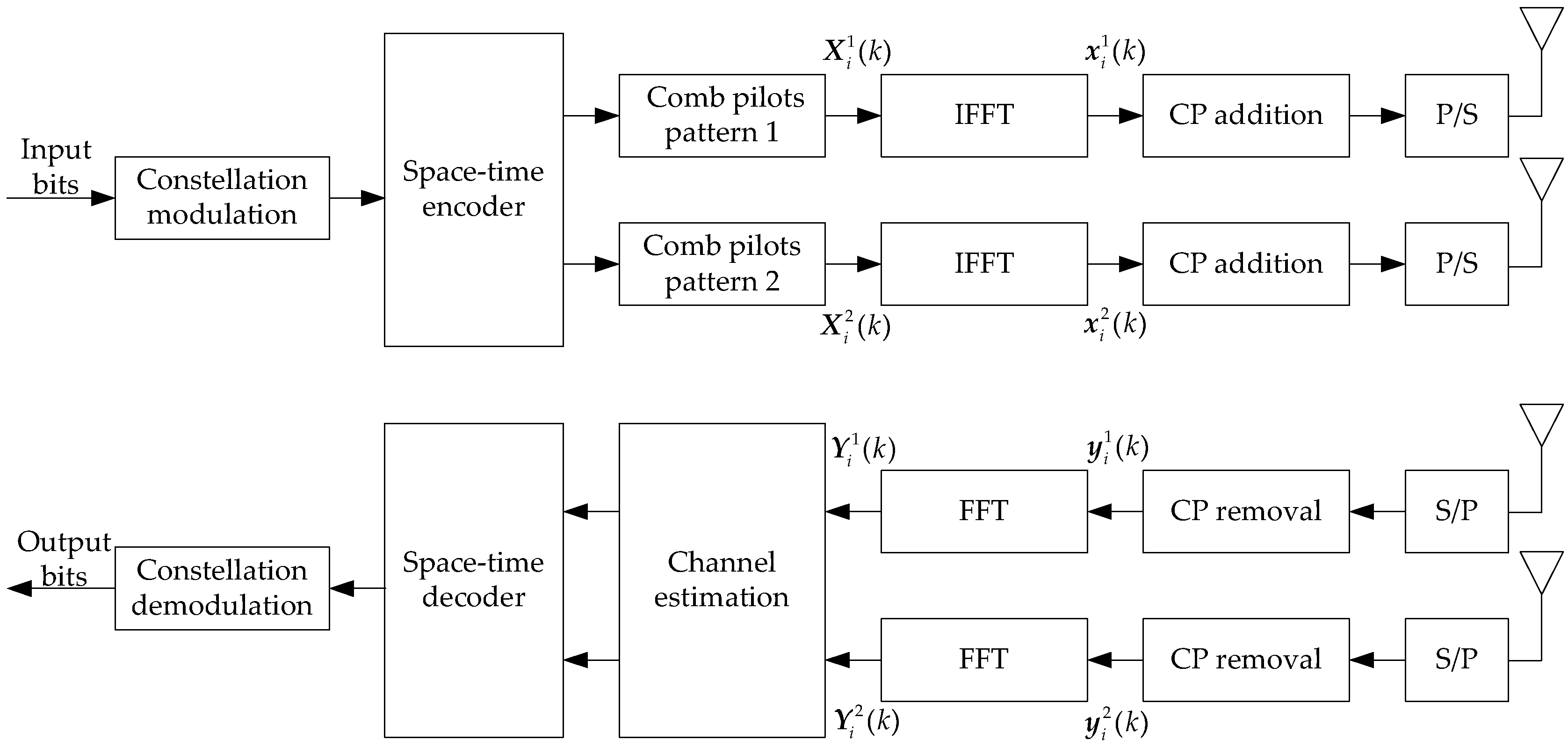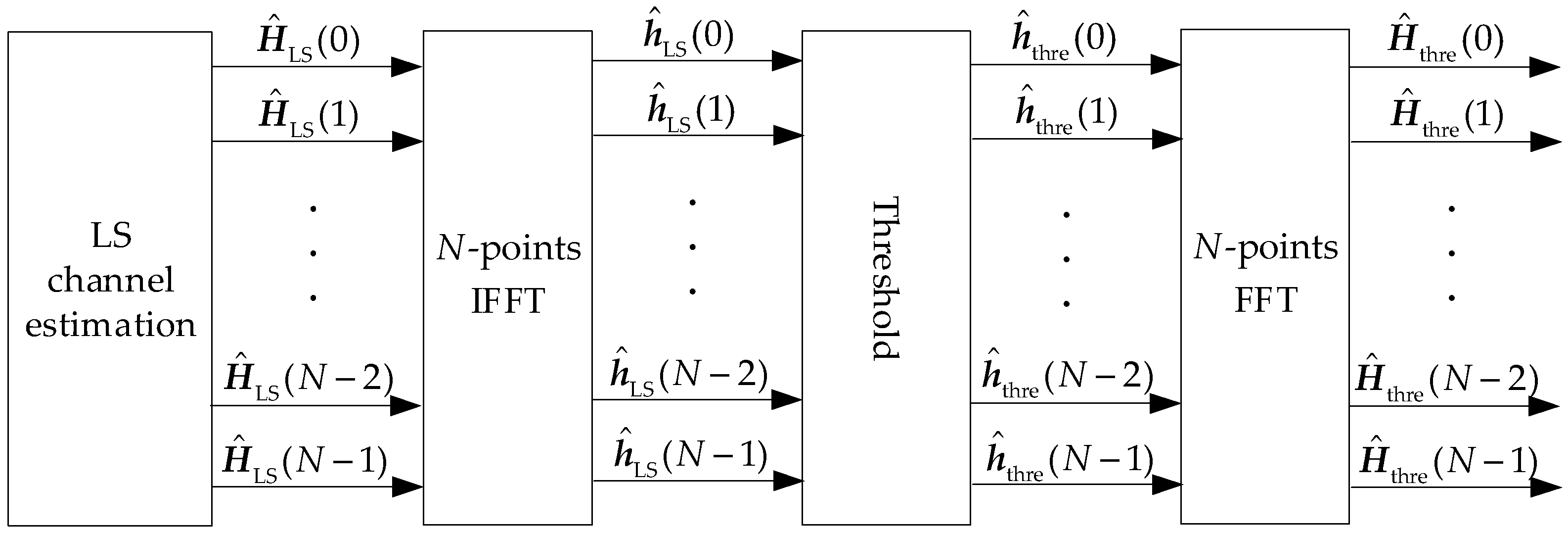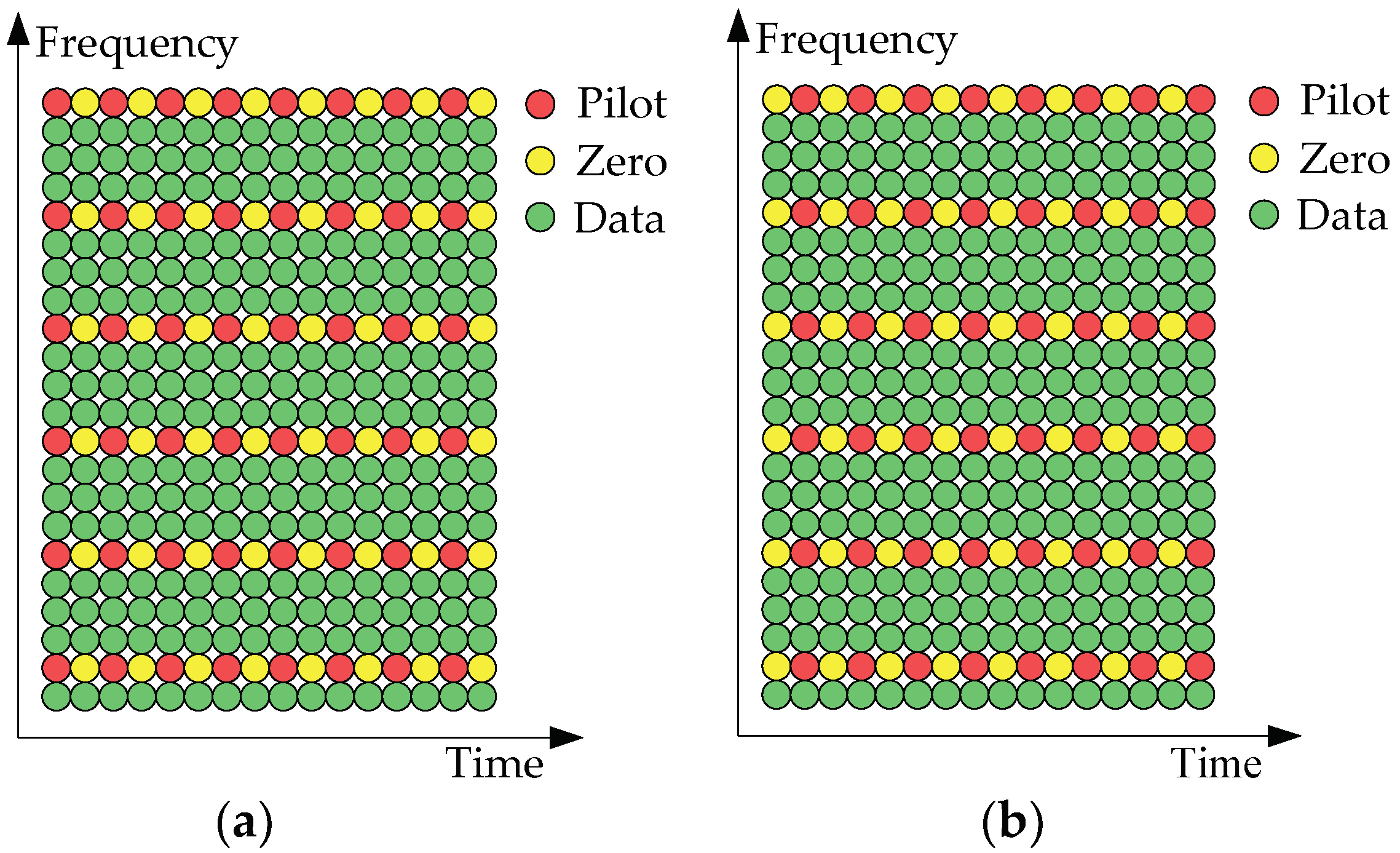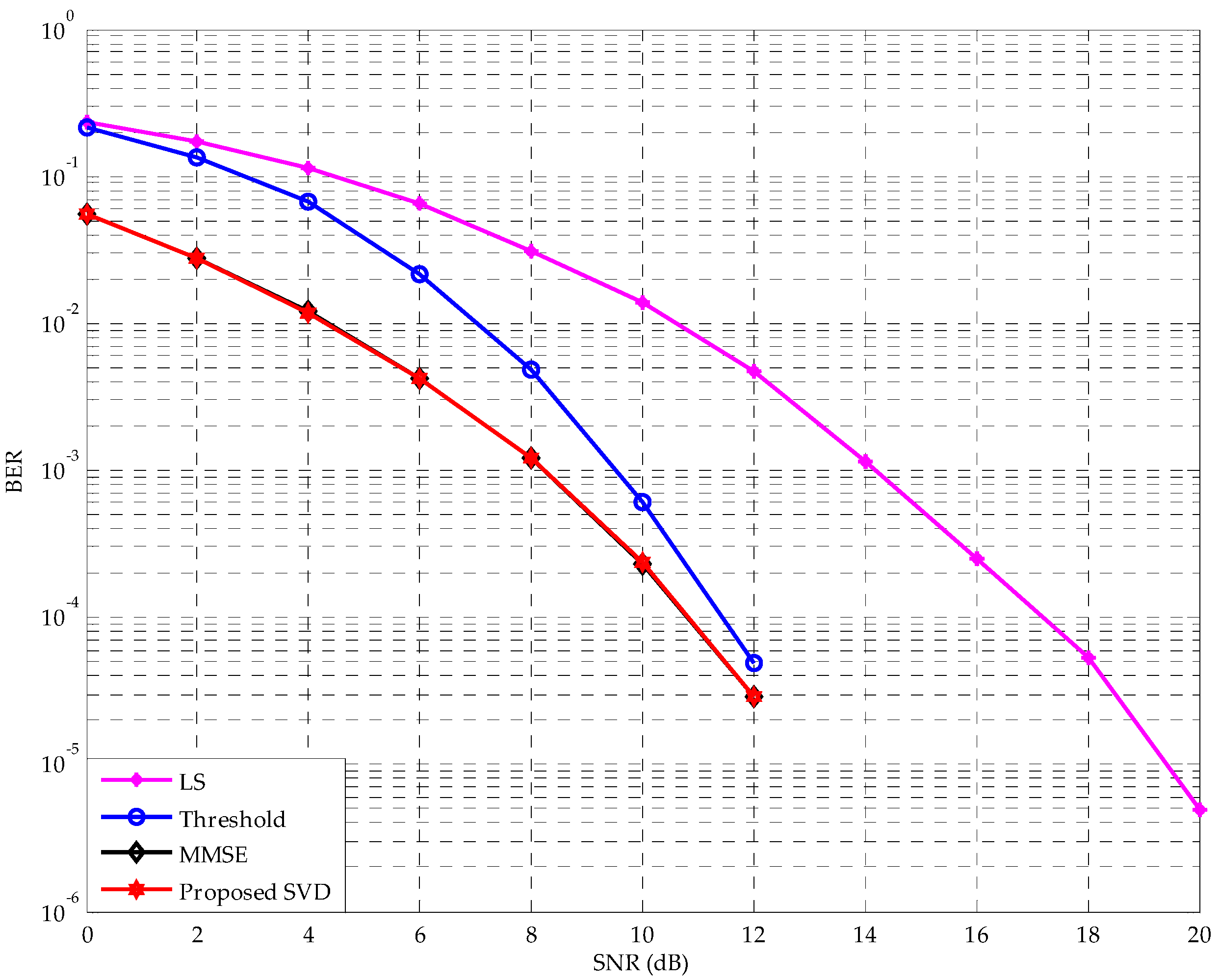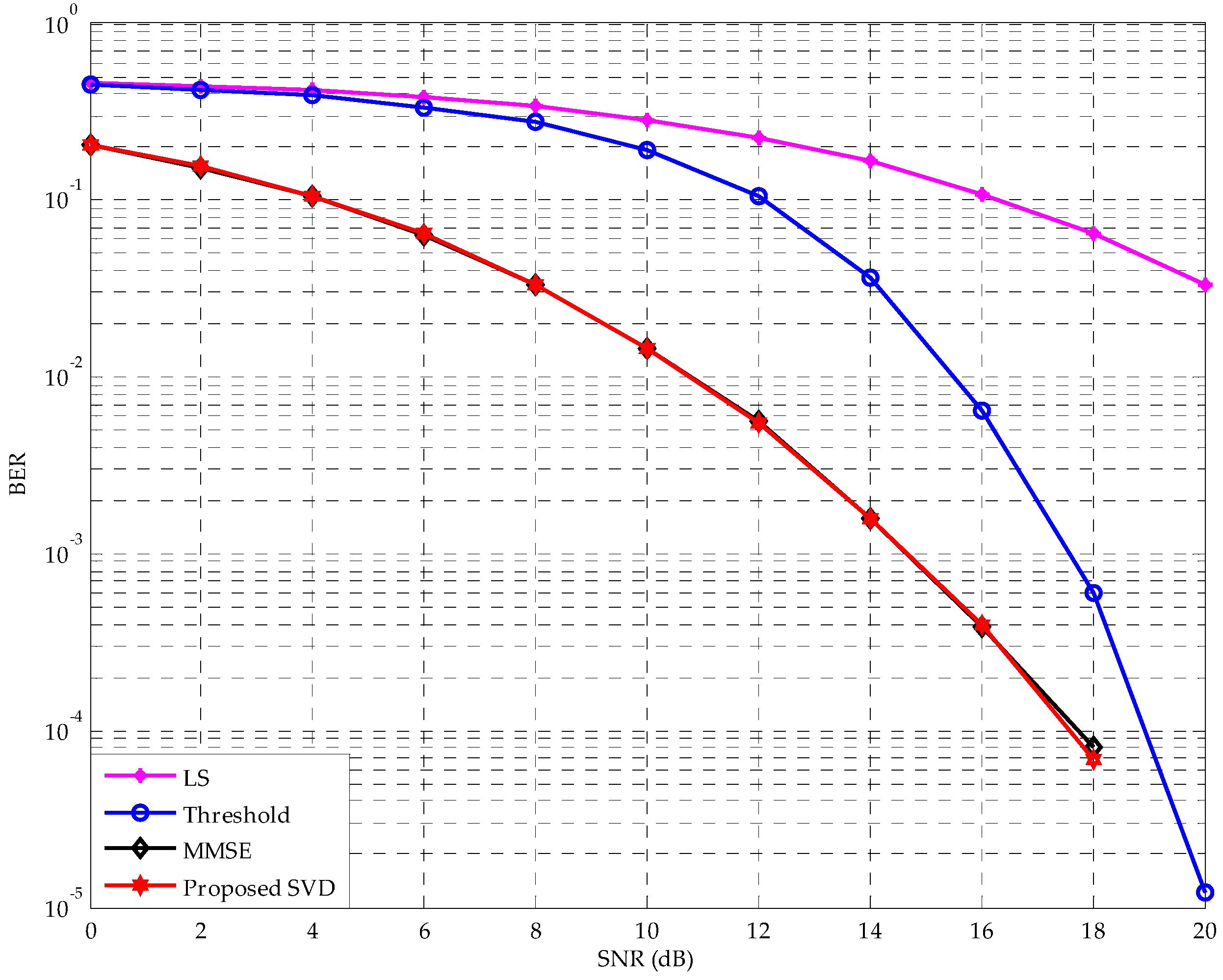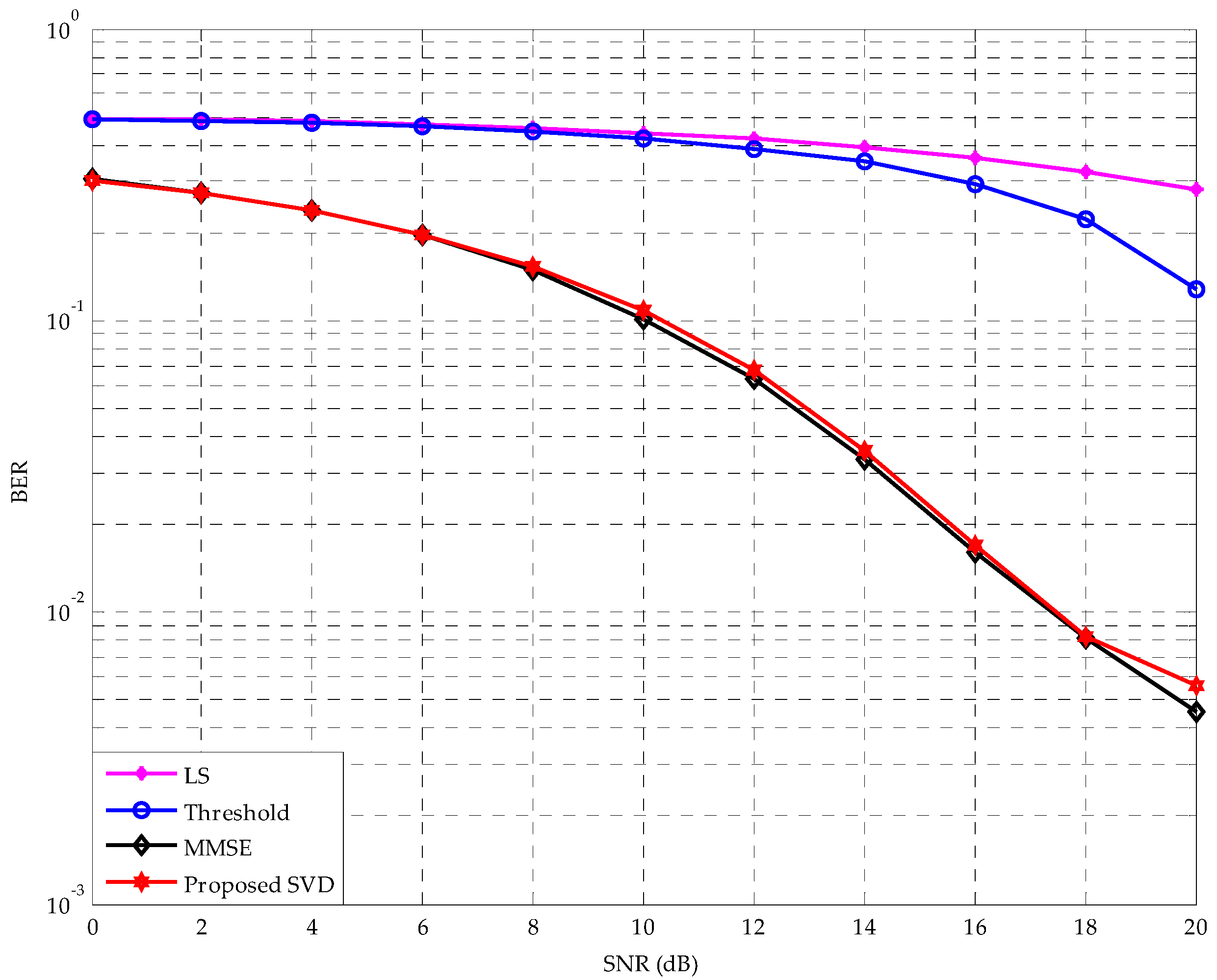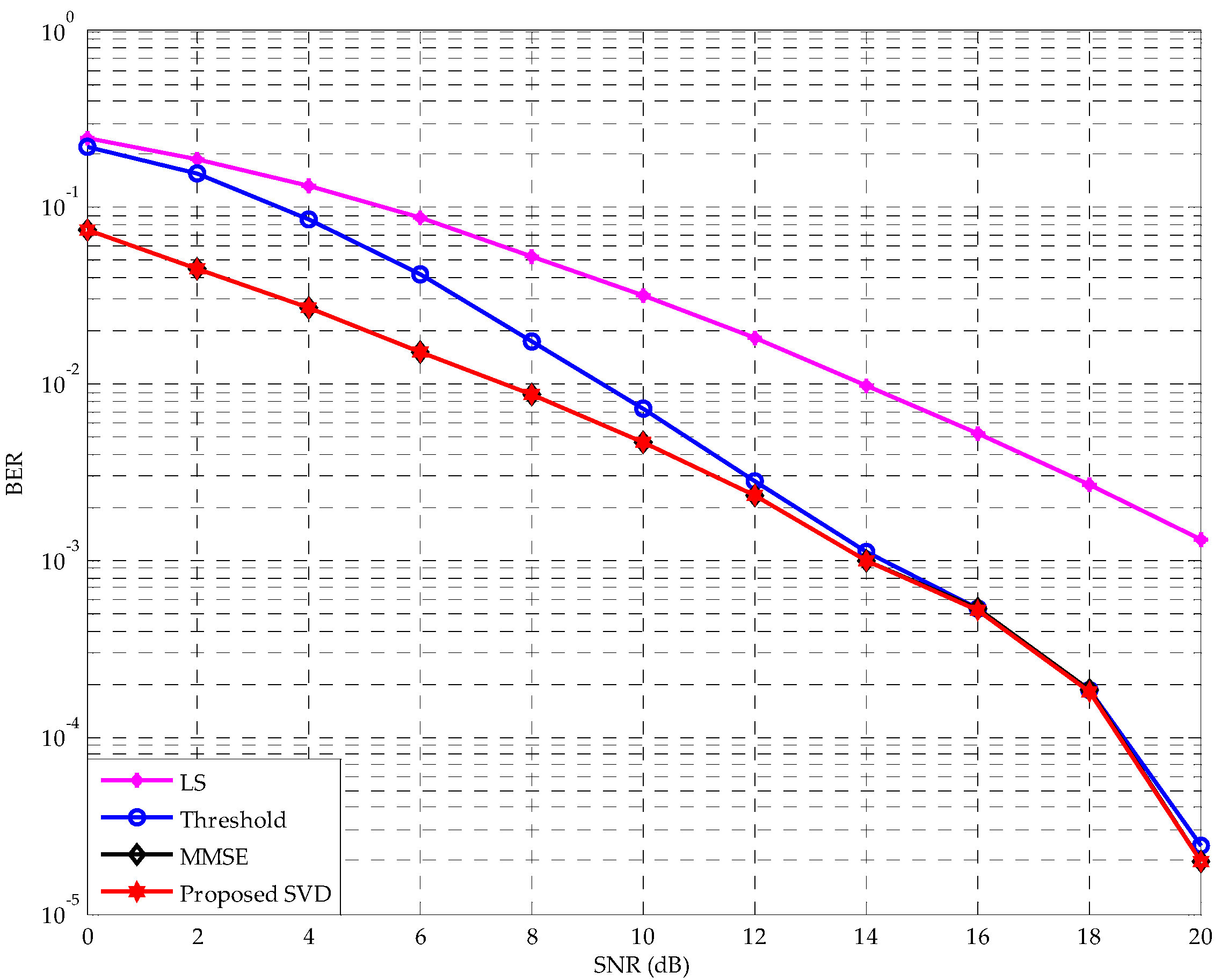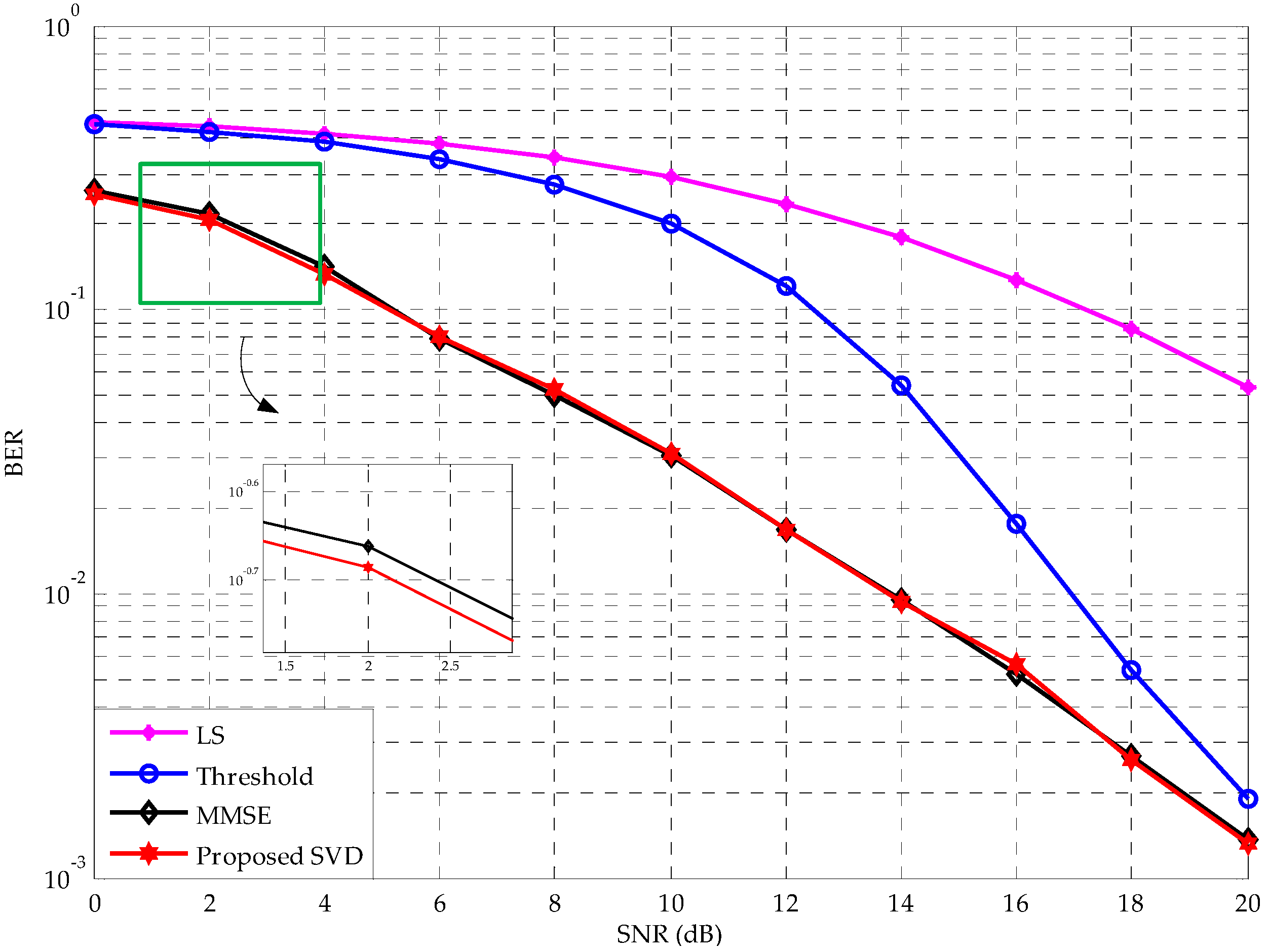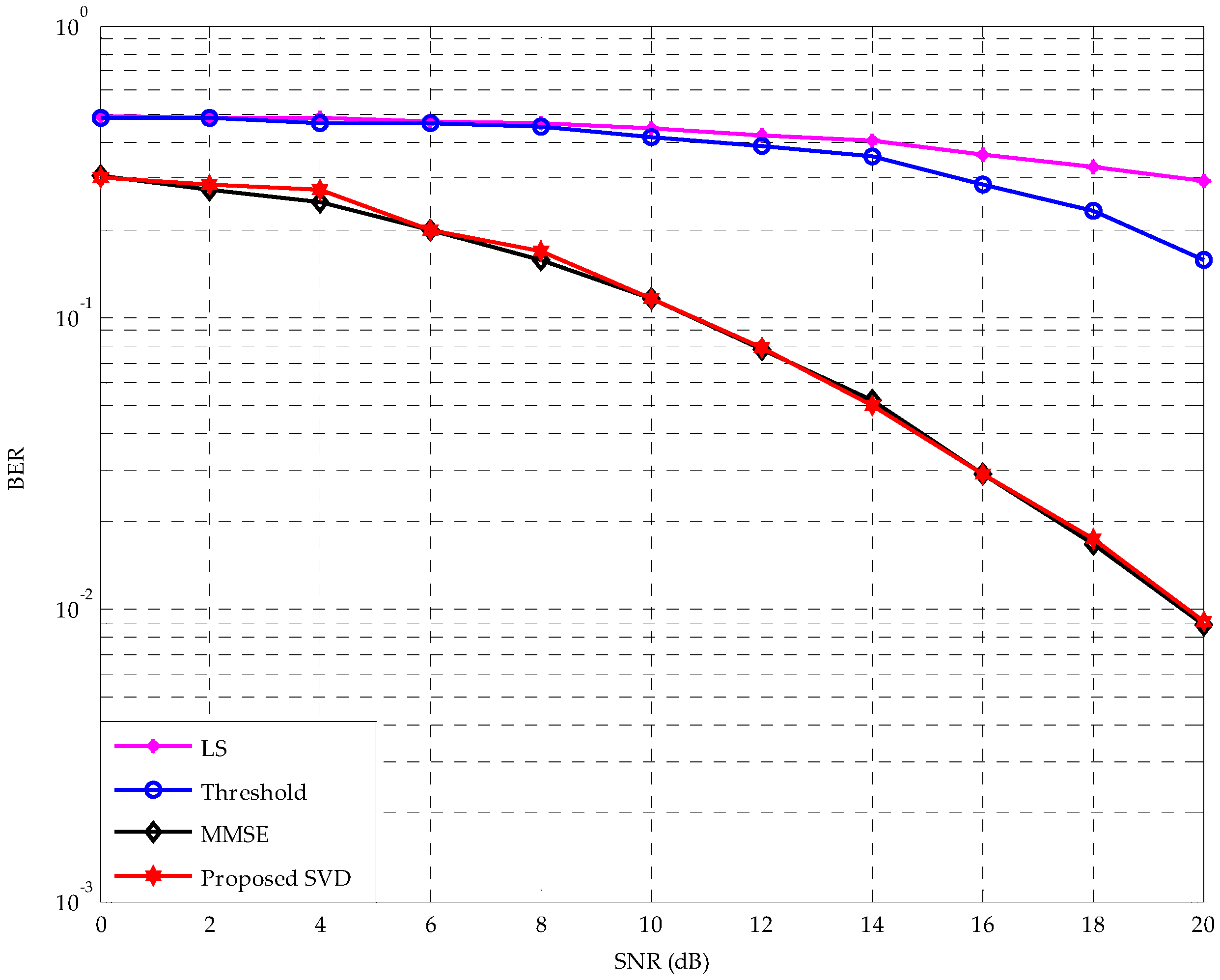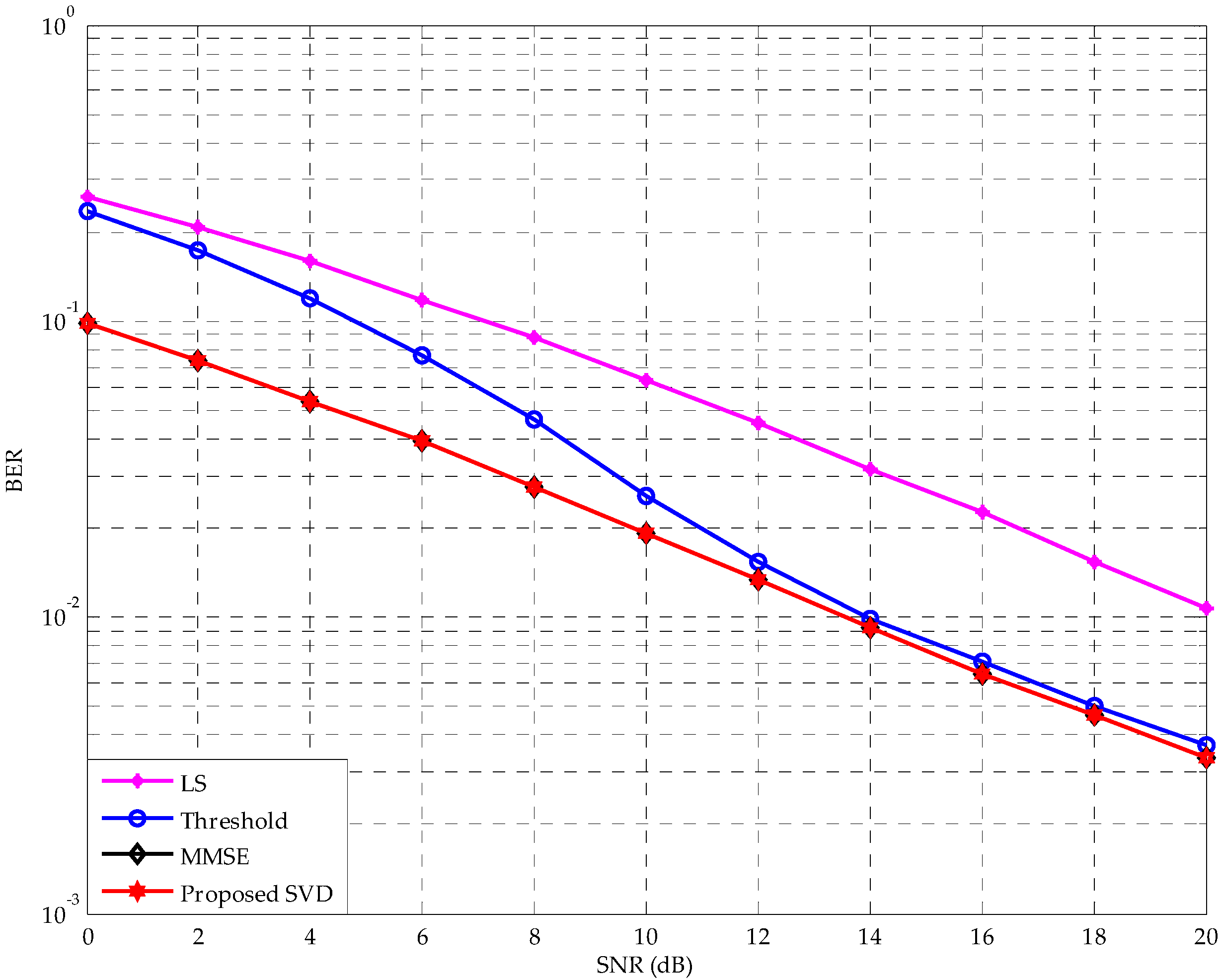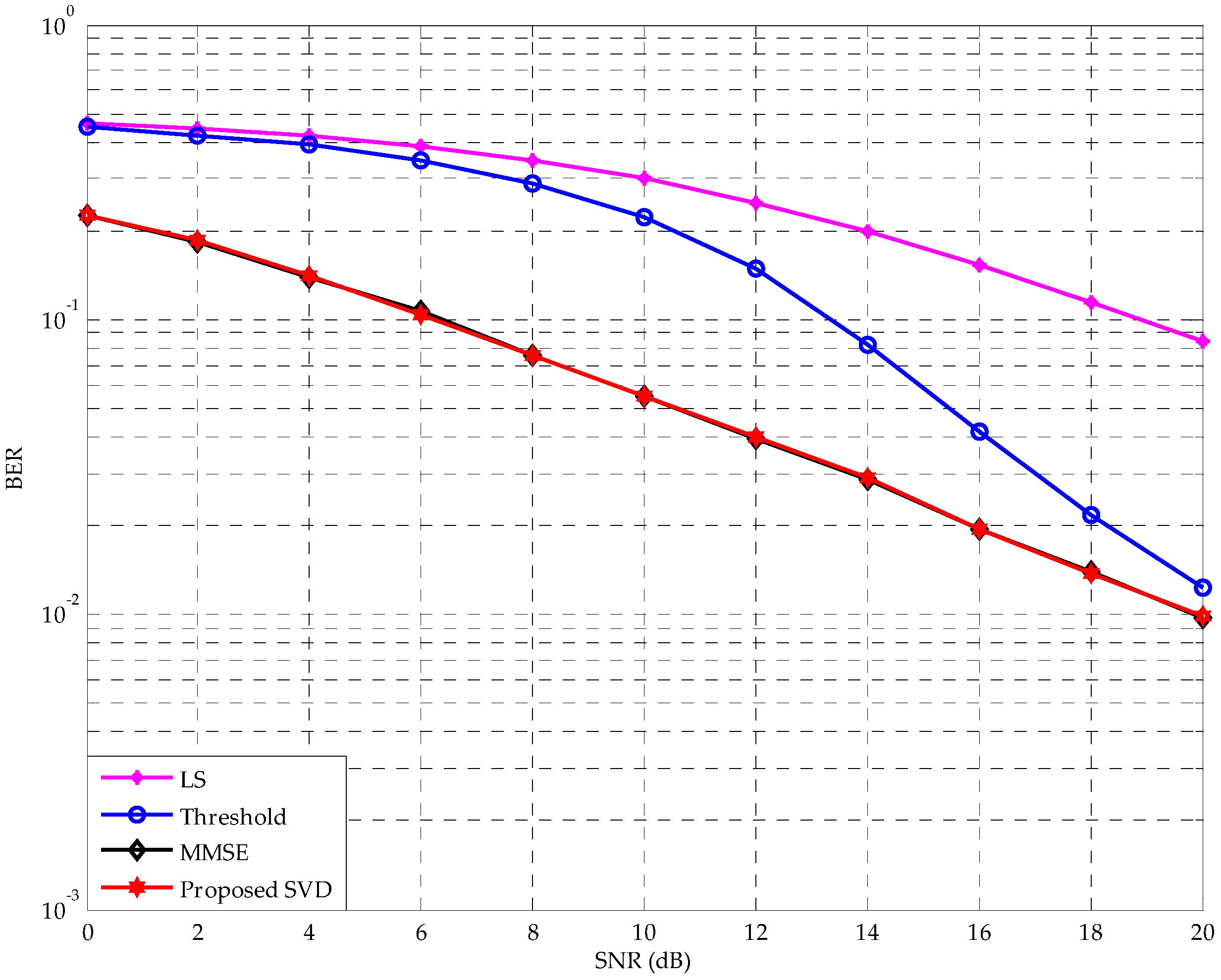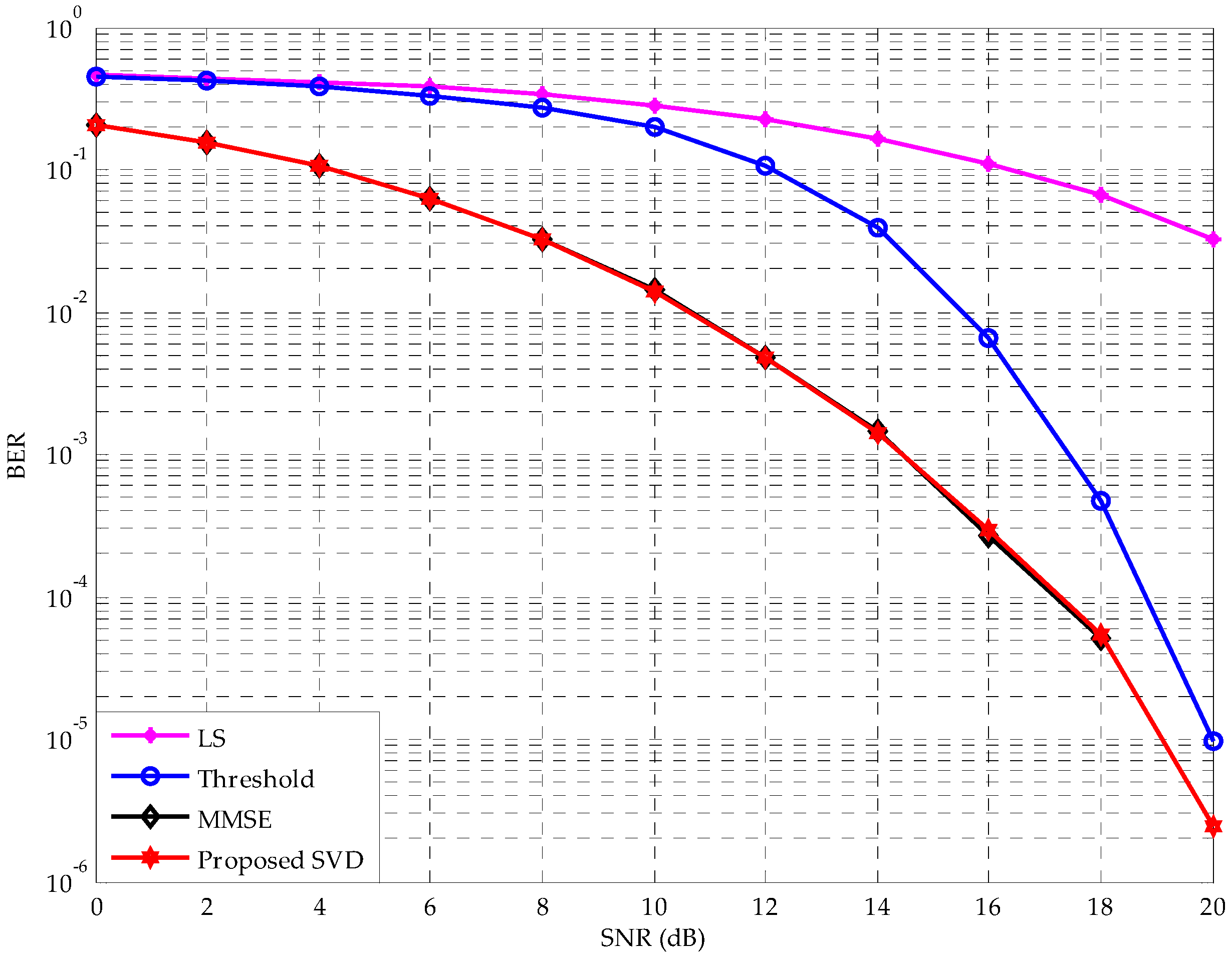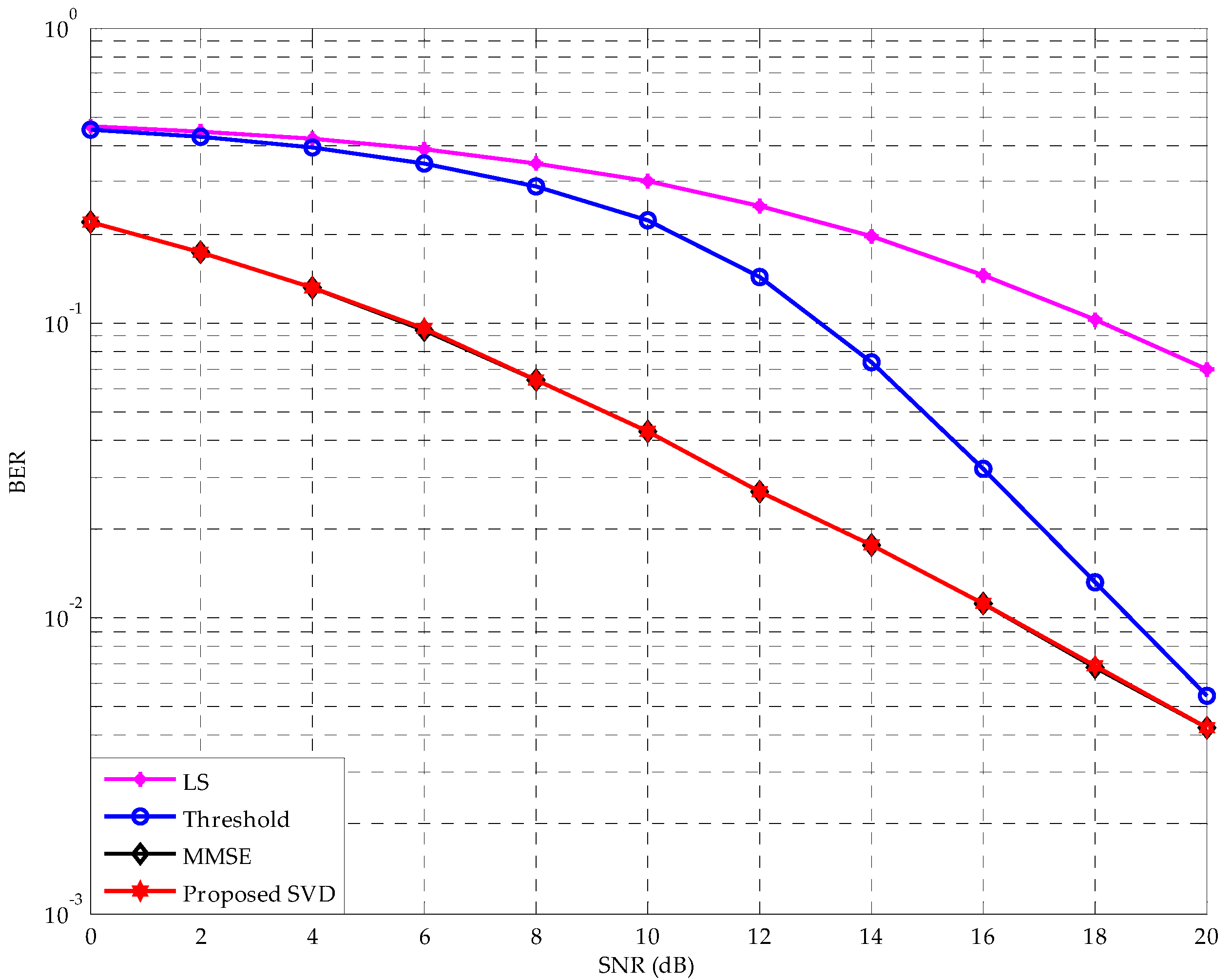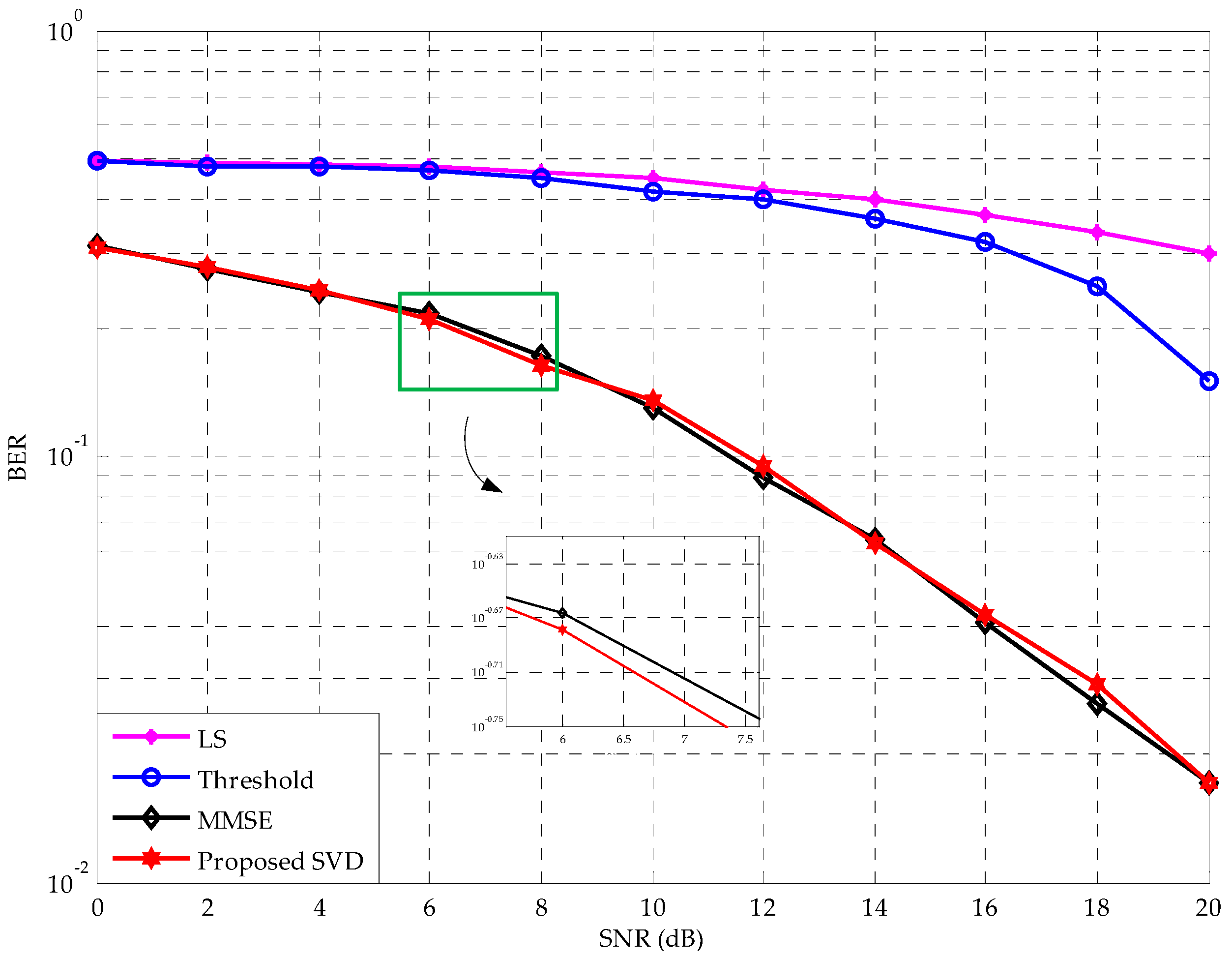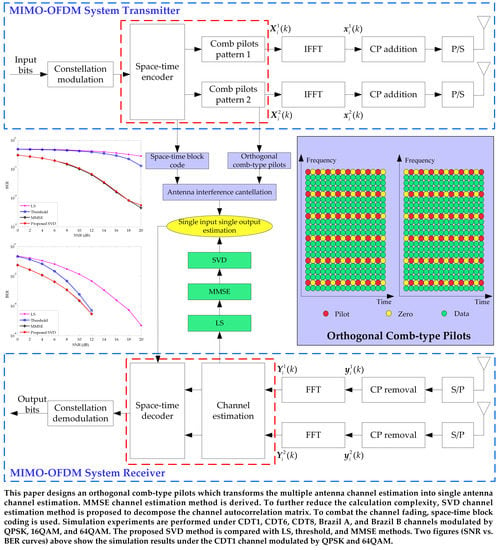1. Introduction
Orthogonal frequency division multiplexing (OFDM) and multiple-input multiple-out (MIMO) technologies have been widely used in wireless communication systems [
1,
2]. The OFDM technology improves the spectrum utilization efficiency. Moreover, inter-symbol interference (ISI) can be avoided by adding the cyclic prefix (CP), which is inserted in the front of the OFDM symbol. The OFDM technology can flexibly select suitable subcarriers for transmission, so the spectrum resource allocation is more flexible. The MIMO technique with multiple antennas at both transmitter and receiver can increase system capacity and link reliability in the multipath propagation environment [
3,
4]. Hence, the combination of MIMO and OFDM technologies could improve the system performance.
By using specially designed channel codes at the transmitter and channel decoding at the receiver in MIMO-OFDM systems, space-time block coding (STBC) can provide diversity transmission gains and combat channel fading effectively. Hence, STBC is widely used in MIMO-OFDM systems [
5]. Space-time block decoding (STBD) requires accurate channel state information (CSI). Due to the effect of additive white Gaussian noise (AWGN) and interference between antennas, CSI cannot be easily obtained in STBC MIMO-OFDM systems. Hence, channel estimation is a key technology to improve the STBC MIMO-OFDM system performance.
There have been many studies on channel estimation in single antenna OFDM systems. Pilot-based channel estimation methods are widely used in communication systems. Pilot-based channel estimation method estimates the channel by inserting the known pilot sequences into the transmitted OFDM symbols [
6,
7]. Pilot symbols are inserted in various patterns, such as block-type, comb-type, and scatter-type to adapt to different channel environments. The comb-type and scatter-type pilots are more adapt to the fast fading channel and block-type pilot is more adapt to the slow fading channel [
8]. The least square (LS) channel estimation method is very simple and has low complexity [
9]. However, the performance of the LS channel estimation method is poor because it is heavily affected by noise. The threshold channel estimation method filters out AWGN in channel coefficients by setting an appropriate threshold. However, the choice of the threshold has great impact on system performance. It is very difficult to select the appropriate threshold to filter out the noise as much as possible. A linear filtering LS (LFLS) channel estimation method was proposed in [
10]. It can keep the energy of the main paths and remove the effect of AWGN. However, the disadvantage of the LFLS method is that the suppression factor of linear filter changes with the change of the channel environment. A novel channel estimation method based on the time-domain threshold was proposed in [
11]. The threshold value was determined by obtaining a standard deviation of estimation noise through the wavelet decomposition of the frequency-domain estimated channel coefficients. This method obtained an appropriate threshold through the wavelet decomposition to filter out the AWGN. However, it cannot be directly applied to multiple antennas systems. An iterative scatter-based channel estimation method for the OFDM/offset quadrature amplitude modulation (OQAM), which reduces the real and imaginary interferences at the receiver to improve the channel estimation, was proposed in [
12]. In OFDM/OQAM systems, the orthogonal condition of the subcarriers is guaranteed from the complex domain to the real domain. OFDM/OQAM also does not use any CP, which improves the spectral efficiency and accuracy of channel estimation.
Inserting pilot sequences into the transmitted data would reduce the spectral efficiency. To solve this problem, the blind channel estimation method is proposed for OFDM systems [
13,
14]. The blind channel estimation method does not require inserting pilots at the transmitter. The relevance of input data and output data can be used to estimate the channel. The blind channel estimation method can transmit more data symbols in a certain time interval. However, blind channel estimation is a very complex method. The semi-blind channel estimation method has a good tradeoff between bandwidth utilization and computational complexity [
15,
16]. The semi-blind channel estimation is the combination of pilot-based and blind channel estimation methods. Semi-blind schemes are computationally simpler than blind channel estimation methods, at the cost of only requiring a few pilot symbols.
Channel estimation in the MIMO-OFDM system is more complex than that in the OFDM system due to the interference between transmit and receive antennas. Many studies are also focused on channel estimation in MIMO-OFDM systems. A fast blind subspace channel estimation method for STBC-OFDM systems based on the circular property of the channel matrix was proposed in [
17]. This method has fast convergence property than conventional blind subspace channel estimation methods. However, it cannot estimate the strong frequency-selectivity and fast fading channels. A sparse Bayesian learning (SBL)-based channel estimation scheme was proposed in an STBC MIMO-OFDM wireless system [
18]. The pilot-based SBL technique obtains successive updates of the approximately sparse MIMO channel based on an expectation maximization formulation for estimation of the SBL channel hyper parameters. The data aided SBL scheme utilizes the maximum likelihood symbol detection to further improve the system performance. Although this method has better performance, the complexity is further improved.
An optimal pilot pattern selection using the cat swarm optimization algorithm is applied in [
19]. It improves the accuracy of channel estimation. During channel estimation, the pilots are optimally selected using the cat swarm optimization algorithm with the fitness of delay and phase, which reduces the mutual coherence and communication complexity. Under the condition of 20 or 100 users, the proposed method has the best bit error rate (BER) performance in static Rayleigh channels. However, it has poor performance in the fast fading channel. A joint maximum likelihood and MMSE estimation based signal detection is proposed for the combination system of radio over fiber link and MIMO-OFDM wireless channel [
20]. It can automatically determine which kind of estimation method can be used according to the channel signal-to-noise ratio (SNR) condition. The advantages of this method are that it has low system complexity and improves the nonlinear effect of radio over fiber link. A robust semi-blind receiver combined with the Tucker-2 model was proposed in [
21]. The proposed receiver has high spectral efficiency and can be used in multi-user massive MIMO systems. The BER performance decreases dramatically with the increase of SNR. However, this method cannot adapt to the fast fading environment.
In this paper, an orthogonal pilot sequence is designed to suppress the interference of pilot symbols from other transmit antennas. The multiple antennas channel estimation problem can be transformed into the single antenna channel estimation problem, which reduces the complexity of the channel estimation. This paper also focuses on the analysis of the STBC and MMSE channel estimation method to improve the system performance. To further reduce the calculation complexity, the singular value decomposition (SVD) is used to decompose the channel autocorrelation matrix. This paper uses different constellation modulation modes such as quadrature phase shift keying (QPSK), 16-quadrature amplitude modulation (16QAM), and 64QAM. Different channel environments such as China DTV Test 1st (CDT1), CDT6, CDT8, Brazil A, and Brazil B are used to test the performance of the STBC MIMO-OFDM system. Simulation results verify that the SVD method combined with STBC has better BER performance than conventional LS and threshold channel estimation methods in the multipath channel environment.
The rest of this paper is organized as follows.
Section 2 starts with an introduction of the system model, and then the STBC is described.
Section 3 introduces two conventional channel estimation methods, which will be used for comparison analysis with the proposed channel estimation method.
Section 4 illustrates the proposed SVD channel estimation method. Experimental results of the proposed method are presented in
Section 5. Conclusions are given finally in
Section 6.
4. The Proposed SVD Channel Estimation Method
LS and threshold methods presented in
Section 3 can easily be implemented in OFDM systems. However, the OFDM symbols received by the receiver of the MIMO-OFDM system are the linear superposition of transmit symbols on each transmit antenna which can be presented as:
where the
vector
is the received OFDM symbol in the
-th receive antenna.
is the number of the transmit antennas. The
diagonal matrix
is the CFR between the
-th transmit antenna and the
-th receive antenna. The
vector
is the transmitting symbol between the
-th transmit antenna and the
-th receive antenna. The pilot symbols can be orthogonal to eliminate the interference between the transmit antennas and receive antennas. Hence, this paper designs an orthogonal comb-type pilot pattern which is shown in
Figure 4.
As shown in
Figure 4, the green filling block represents transmitted data symbols. The yellow filling block represents zero, and the red filling block represents the transmitted pilot symbol. The pilot positions of the two antennas are orthogonal to each other, and the pilot symbols are orthogonal to each other. According to this pilot pattern, for a particular transmit antenna pair, the pilot symbols cannot be affected by other transmit antenna symbols. As a result, MIMO channel estimation can be converted into a number of independent single input and single output channel estimation problems. The estimated CFR
between the
-th transmit antenna and the
-th receive antenna according to the LS method which can be represented as:
where
is the received pilot symbol on the
-th subcarrier between the
-th transmit antenna and the
-th receive antenna.
is the transmitted pilot symbol on the
-th subcarrier of the
-th transmit antenna. According to the spline interpolation, the CFR
in data positions can be obtained.
In the threshold channel estimation method, it is difficult to choose the appropriate threshold to suppress the noise in channel coefficients, which restrains the application in real scenario. The MMSE channel estimation method has better performance than the LS and threshold methods since it is optimum in minimizing the mean square error (MSE) of the channel estimates in the presence of AWGN. According to the pilot sequence designed in
Figure 4, the MMSE channel estimation can be directly applied in STBC MIMO-OFDM systems without increasing the computational complexity. However, the MMSE channel estimation method requires the inverse operation of the channel correlation matrix, which has a large amount of computation. To further reduce the calculation complexity, the SVD method is used to decompose the channel autocorrelation matrix which avoids the matrix inversion operation. In
Appendix A, the MMSE channel estimation method in STBC MIMO-OFDM systems can be represented as:
where
is the
channel autocorrelation matrix.
is the transmitted pilot symbol. The
vector
is the CFR obtained by the LS method. The superscript
denotes the Hermitian transpose.
is the variance of the AWGN in the channel. The complexity of the MMSE can be significantly reduced by averaging the transmitted pilot data. The term
in Equation (9) can be replaced by its expected value of
. The expected value of
can be represented as:
where
denotes the pilot symbols in matrix
and
is the
identity matrix. Defining the
as
, the simplified MMSE channel estimator can be represented as [
20]:
where
is a constant value depending on the signal constellation. For QPSK, its value is 1; for 16QAM, its value is 17/9; for 64QAM,
is 13/5. To further reduce the complexity of the MMSE estimator, the SVD is used to decompose the channel autocorrelation matrix. The SVD of the channel autocorrelation matrix
is [
24]:
where
and
are
unitary matrices containing the singular vectors, and
is a
diagonal matrix containing the singular values
on its diagonal in descending orders. The SVD method can be represented as [
24]:
where
is a
diagonal matrix and the elements on its diagonal are:
where
is the length of the CP.
5. Simulation Results
The BER performance of the proposed SVD channel estimation method is shown in this section. The simulation is performed in static multipath channel environments and adopts three constellation modulation modes of QPSK, 16QAM, and 64QAM, respectively. The Rayleigh fading multipath channel models are CDT1, CDT6, CDT8, Brazil A, and Brazil B channels [
23,
25]. These channels have six paths. Each channel has a different delay time and power. These channels have different frequency-selectivity.
The main simulation parameters based on the STBC MIMO-OFDM system are presented in
Table 1. The profiles for the CDT1, CDT6, and CDT8 channel models are shown in
Table 2. The profiles for the Brazil A and Brazil B channel models are shown in
Table 3.
Four channel estimation methods, LS, threshold, MMSE, and SVD, are presented in the STBC MIMO-OFDM system. As can be seen from
Table 1, in the STBC MIMO-OFDM system, different modulation modes, such as QPSK, 16QAM, and 64QAM, are applied to test the system performance. There are two transmit antennas and two receive antennas in the STBC MIMO-OFDM system. The pilot interval is one subcarrier. The total number of subcarriers is 2048. The CP occupies 256 subcarriers. One OFDM block consists of 10 OFDM symbols. The comb-type pilot pattern in
Figure 4 is used to estimate the CSI.
Under the QPSK, 16QAM, and 64QAM modulation modes, the BER performance curves in the CDT1 channel are shown in
Figure 5,
Figure 6 and
Figure 7, respectively.
As can be seen from
Figure 5, the BER curves of four channel estimation methods show a downward trend. The LS method does not suppress the AWGN. Hence, its performance is the worst. Although the SVD method is a simplification of the MMSE method, its performance is very close to that of the MMSE method. Since the energy of the channel is mainly concentrated on the first
singular values of the channel autocorrelation matrix. The noise suppression performance of the proposed SVD channel estimation method is similar to that of the MMSE method. Hence, the performance of the proposed SVD method is very close to that of the MMSE method. At the BER of
, the SVD method outperforms the threshold and LS methods by about 2.7 dB and 6.3 dB SNR gains, respectively. At the BER of
, the SNR loss is about 1.3 dB between the threshold and SVD methods, and a 5.9 dB SNR loss between the LS and SVD methods. Hence, the SVD method increases the accuracy of channel estimation and can be used to estimate the slightly frequency-selectivity CDT1 channel.
As can be seen from
Figure 6, as the SNR increases in the STBC MIMO-OFDM system, the simulation results of four channel estimation methods are decreased in terms of BER. Under the same conditions, the proposed SVD method has the lowest BER. Therefore, it provides the best BER performance especially under high SNR range. The LS method has the worst BER performance. At the BER of
, compared with the threshold channel estimation method, the SVD method has about 4.7 dB SNR gains. At the BER of
, the SVD method outperforms the threshold channel estimation method by about 2.9 dB SNR gains. Hence, under the 16QAM modulation mode, the SVD method can also be well applied to the STBC MIMO-OFDM system.
In the 64QAM modulation, one symbol carries six binary bits, thus increasing the transmission rate in the MIMO-OFDM system. Under the condition of two transmit and two receive antennas, the 64QAM modulation can provide various phases, it could significantly increase the transmission rate. As can be seen from
Figure 7, under the 64QAM modulation mode, the proposed SVD method also has good performance. Hence, the proposed method can adapt to the 64QAM modulation mode.
Under the QPSK, 16QAM, and 64QAM modulation modes, the BER performance curves in the CDT6 channel are shown in
Figure 8,
Figure 9 and
Figure 10, respectively.
Figure 8 and
Figure 9 are simulated under the CDT6 channel environment. The BER of four channel estimation methods under the CDT6 channel is higher than in the CDT1 channel due to the stronger frequency-selectivity of the CDT6 channel. In
Figure 8, at the BER of
, the SVD method outperforms the threshold and LS methods by about 1.8 dB and 6.4 dB SNR gains, respectively. At the BER of
, compared with the threshold method, the SVD method has about 0.35 dB SNR gains. In
Figure 9, although the BER performance of the 16QAM modulation mode is worse than that of the QPSK modulation mode, the SVD method still has good performance. At the BER of
, the SVD method outperforms the threshold method by about 3.1 dB SNR gains. To clearly see the SNR gains between the SVD and MMSE methods, this paper amplifies the green box part in
Figure 9. It can be seen from the amplified part, the SVD method outperforms the MMSE method by about 0.3 dB SNR gains at the BER of
. Hence, SVD channel estimation can be well used in the CDT6 channel to obtain the CFR. As can be seen from
Figure 10, the proposed SVD method has good performance under the CDT6 channel with the 64QAM modulation mode due to fact that the proposed SVD method can suppress the noise effectively. The 64QAM modulation includes 64 constellation points and is more susceptible to AWGN. The LS and threshold methods cannot suppress the AWGN effectively. Hence, with the increase of SNR, the BER curves of the LS and threshold methods decrease slowly.
Under the QPSK and 16QAM modulation modes, the BER performance curves in the CDT8 channel are shown in
Figure 11 and
Figure 12, respectively.
As can be seen from
Figure 11 and
Figure 12, the BER curves of four channel estimation methods show a downward trend. The performance with the QPSK and 16QAM modulation modes is presented in the CDT8 channel. The CDT8 channel has stronger frequency-selectivity than the CDT6 channel. However, the proposed SVD method still shows the advantages of channel estimation in MIMO-OFDM systems. In
Figure 11, at the BER of
, compared with the threshold and LS methods, the SVD method has about 3.3 dB and 6.9 dB SNR gains, respectively.
In
Figure 12, at the BER of
, the SVD method outperforms the threshold and LS methods by about 7.1 dB and 12.7 dB SNR gains, respectively. The threshold channel estimation method does not perform well due to an inaccurate selection of the threshold. The SVD method can suppress the noise effectively and has better performance than threshold and LS channel estimation methods. Hence, the SVD channel estimation method can show obvious advantages in the CDT8 channel with a strong frequency-selectivity.
Under the 16QAM and 64QAM modulation modes, the BER performance curves in Brazil A channel are shown in
Figure 13 and
Figure 14, respectively.
As can be seen from
Figure 13 and
Figure 14, the proposed SVD channel estimation method can be well applied to the Brazil A channel. In
Figure 13, at the BER of
, the SVD method outperforms the threshold method by about 4.9 dB SNR gains. At the BER of
, the SVD method outperforms the threshold method by about 3.1 dB SNR gains. In
Figure 14, the SVD method has a good performance in the 64QAM modulation scheme. With the increase of SNR, the BER curves of the LS and threshold methods decrease slowly due to the influence of AWGN. At the BER of
, the proposed SVD method has about 0.27 dB SNR gains than the MMSE method. Although the performance of the SVD method is only slightly better than that of the MMSE method, the selected singular values can recover the information of CSI to a great extent and suppress the noise at the same time.
Under the 16QAM and 64QAM modulation modes, the BER performance curves in the Brazil B channel are shown in
Figure 15 and
Figure 16, respectively.
The strong frequency-selectivity of the Brazil B channel will reduce the BER performance of channel estimation methods. However, the SVD channel estimation method has a better performance than LS and threshold methods. In
Figure 15, at the BER of
, the SVD method outperforms the threshold and LS methods by about 7.4 dB and 12.4 dB SNR gains, respectively. In
Figure 16, the SVD method has a better performance than the threshold and LS methods under the Brazil B channel. The BER performance curves of the SVD channel estimation method decrease with the increase of SNR. At the BER of
, the proposed SVD method outperforms the MMSE method by about 0.3 dB SNR gains. Hence, the SVD channel estimation method can be used under the condition of the 64QAM modulation and strong frequency-selectivity Brazil B channel.
The computational complexity of four channel estimation methods is shown in
Table 4. It can be seen that there is no multiplication in the LS and threshold methods. Both the LS and threshold methods only need the
points division. Hence, the LS and threshold channel estimation methods have a low complexity. However, these two methods could not provide a good BER performance in multipath channels. In the MMSE channel estimation method of Equation (11),
is a
channel autocorrelation matrix. The inverse of
is a
matrix. The inverse operation of
has a high calculation complexity. The CFR
obtained from the LS channel estimation method is a
vector. Hence, the MMSE channel estimation method needs the
point multiplication and has the highest calculation complexity among these four channel estimation methods. In the SVD channel estimation method of Equation (13), after the SVD operation of the channel autocorrelation matrix
,
and
are
matrices.
is a
diagonal matrix. Since the number of significant taps is much lower than the number of subcarriers, there will be only a few significant singular values in
. Hence, the first
values in the diagonal of
are retained and other values are set to zero.
is the length of CP. The SVD method simplifies the channel estimation complexity and it only needs the
point multiplication.
Although the SVD of the channel autocorrelation matrix reduces the number of multiplication for the channel estimation, obtaining the SVD of the autocorrelation matrix by itself is computationally complex like the inverse operation. The SVD operation of the channel autocorrelation matrix has a certain complexity, but it only decomposes the channel autocorrelation matrix once. With the increases of SNR, the SVD operation is not performed. However, the inverse operation of the channel autocorrelation matrix is required for every change of SNR. The inverse operation of the channel autocorrelation matrix also has a high complexity when the number of subcarriers is large. Hence, the proposed SVD method has a lower calculation complexity than the MMSE method.
